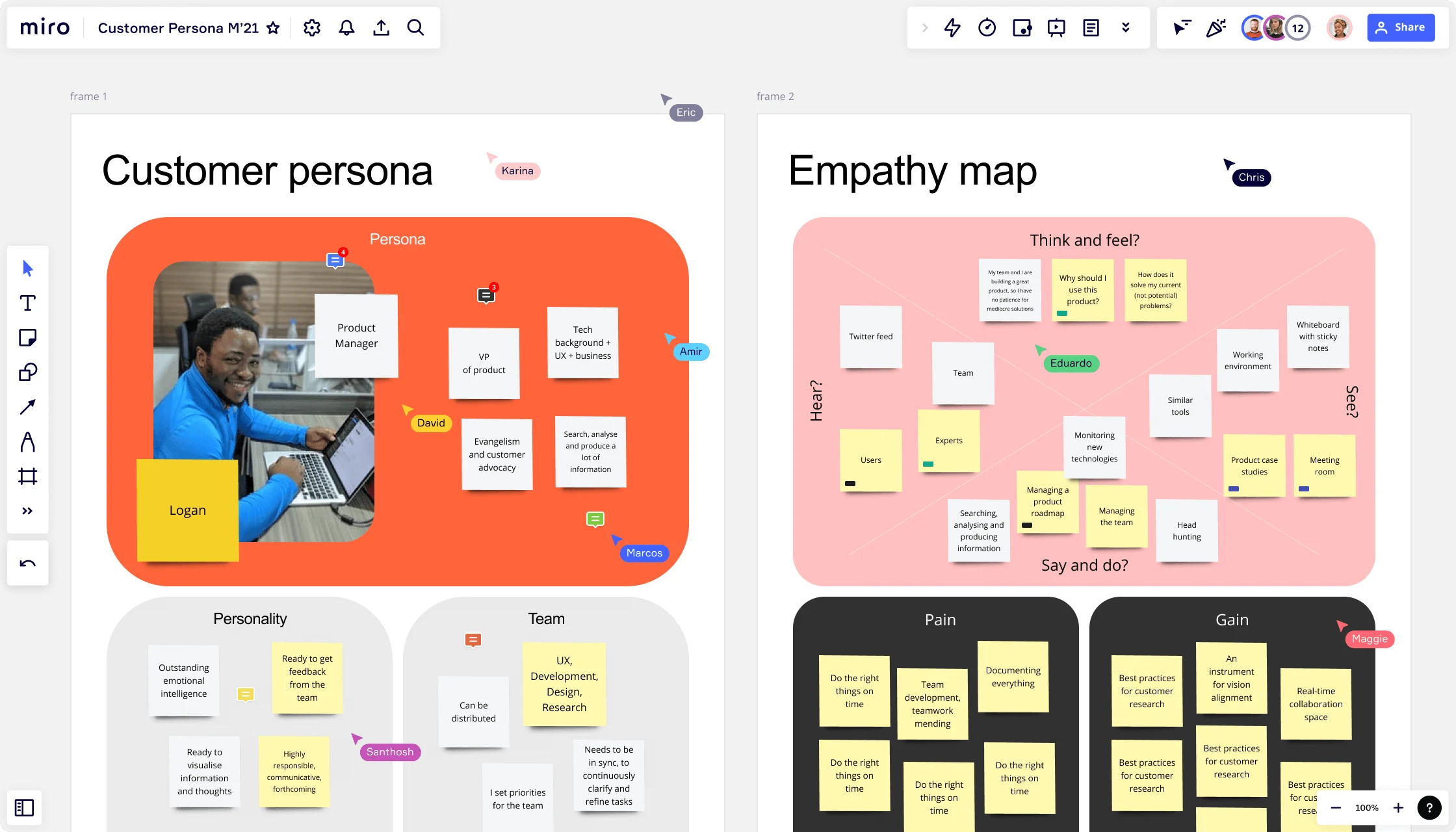
What is co-creation of value?

Summary
In this guide, you will learn:
- Co-creation shifts from company-centric to collaborative, engaging users in design to create shared value.
- Originates from service-dominant logic, emphasizing value creation via company-customer interaction.
- In UX, co-creation means continuous designer-user collaboration, aligning products with user needs.
- Leads to higher user satisfaction and engagement (e.g., Adobe, Google).
- Methods include user-generated content, crowdsourcing, beta testing, and customer feedback.
- A strategic necessity in modern business, enabling innovation through partnerships with customers, users, partners, and employees, supported by technology.
Try Miro now
Join thousands of teams using Miro to do their best work yet.
User Experience (UX) has become a critical component in the digital world. It encompasses all aspects of the end-user's interaction with a product or service. As businesses strive to provide more engaging and personalized experiences, value co-creation in UX has emerged as a key strategy. But what exactly is co-creation of value in UX, and why is it so important? This article explores the fascinating intersection of user experience and co-creation, offering insights into how this approach can enhance your UX strategy.
What is co-creation of value?
Co-creation of value represents a shift from a traditional, company-centric perspective to a more collaborative approach. It involves engaging users in the design process, leveraging their insights to shape the experience, thereby creating shared value. The concept originated from the service-dominant logic in marketing, where value is seen as co-created through the interaction between companies and customers.
In the context of UX, co-creation emphasizes collaboration between designers and users throughout the design process. This stands in contrast to traditional approaches, which often involve a linear path from design to deployment, with limited user involvement.
Why is co-creation of value important in UX?
So, why is co-creation crucial in today's UX landscape? Firstly, it places the user at the heart of the design process. By involving users directly, co-creation helps ensure that the final product or service aligns closely with user needs, preferences, and contexts. This alignment enhances the relevance and usefulness of the product, leading to increased user satisfaction.
Several case studies attest to the success of co-creation strategies. For instance, companies like Adobe and Google have used co-creation approaches to refine their products, leading to notable improvements in user satisfaction and engagement. The success of these strategies underscores the fact that value co-creation is not merely a theoretical concept but a practical tool that can lead to tangible benefits.
Process of co-creation in UX
Co-creation in UX doesn't just happen—it requires careful planning and execution. It begins with user research, which helps identify user needs and preferences. Tools like surveys, interviews, and user observations can provide valuable insights into user behavior and expectations.
Next comes the design stage, where these insights are translated into potential solutions. This stage is iterative, involving designing, testing, and refining cycles based on user feedback. Miro, a collaborative workspace, is an excellent tool for this stage, providing an interactive surface where designers and users can brainstorm and visualize solutions together.
The final step is validation, where the proposed solutions are evaluated to ensure they effectively meet user needs. This might involve usability testing, user reviews, or beta testing with a select group of users.
Tools and techniques for co-creation in UX
There are several tools and techniques that can facilitate co-creation in UX. As mentioned earlier, Miro is a valuable tool for collaborative design, providing a shared space where ideas can be visualized and refined.
Another important technique is the use of personas and journey maps. These help to capture user characteristics and experiences, making them tangible for the design team. By embodying user perspectives in this way, these tools can help to ensure that the design process stays user-focused.
However, co-creation is not without its challenges. It requires a shift in mindset from both designers and users, who may be used to more traditional, one-way processes. Overcoming these challenges often involves careful facilitation, clear communication, and a commitment to user involvement at all process stages.
Future trends in UX
The field of co-creation is dynamic and rapidly evolving, with several exciting trends on the horizon. One such trend is the growing role of artificial intelligence and machine learning in co-creation. These technologies can help to streamline the co-creation process, for example by automating parts of the user research process or by providing personalized design recommendations.
Another promising direction is the integration of co-creation with other emerging UX trends, such as voice user interfaces (VUIs) or virtual reality (VR). These technologies offer new avenues for user interaction and involvement, potentially leading to even richer co-creation experiences.
Conclusion
In summary, the co-creation of value in UX represents a powerful approach to user experience design. By involving users directly in the design process, co-creation can lead to more relevant and satisfying user experiences. Whether you're a seasoned UX professional or a newcomer to the field, co-creation offers exciting possibilities for enhancing your UX strategy.
However, it's important to remember that co-creation is not a one-size-fits-all solution. Each co-creation journey will be unique, reflecting your users' specific needs and contexts. But with the right tools and mindset, co-creation can become a valuable addition to your UX toolkit.
As we look to the future, we expect to see the role of co-creation in UX continue to grow. With advancements in AI, machine learning, and other technologies, co-creation possibilities are expanding. And as more companies recognize the benefits of this approach, co-creation is set to become an increasingly central part of the UX landscape.
Happy co-creating!
Author: Miro Team
Last update: October 22, 2025